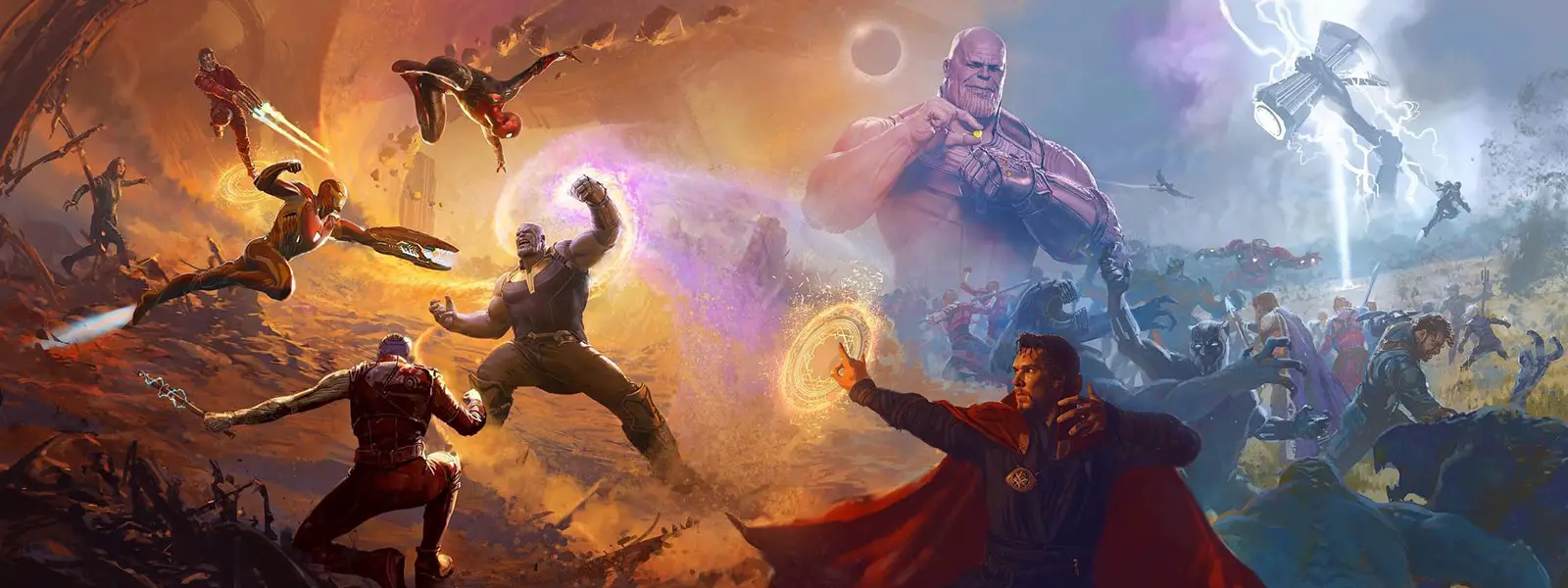On this site, we love the shared universe. Like, crazy-jump-up-and-down-make-a-whole-website-about-them kind of love. Shared universes are at the center of what we do here. Most of our timelines involve a shared universe. Now you might be thinking of a shared universe as something like the Marvel Cinematic Universe, but that’s only part of it. The MCU is a “cinematic” shared universe. You can have a lot of shared universes that use other mediums besides film as their tentpole platform.
So below are our top picks for the best shared universes, which we define as multiple series that come together to form a whole. These can be stories told on different platforms, or different series of stories on the same platform that are part of a larger series. We’ve sorted these based on the level of complexity, critical reception, and fan response, but if you disagree with our order be sure to let us know in the comments below.
15) DCEU
Okay, so this first one might not be a critical success, but it has been a financial success and it’s hugely ambitious. The DCEU (or DC Extended Universe) started with the polarizing Man of Steel and the even more polarizing Batman v Superman: Dawn of Justice. While off to a rocky start, we believe this one has a lot of potential, especially for fan-favorite characters like Wonder Woman, Harley Quinn, or Shazam who haven’t had much of a spotlight in the past. So while we won’t rank this one higher than #15, we think it still deserves to be on the list.
See our DCEU timeline.
14) X-Men Cinematic Universe
The original X-Men film was one of the films that launched the superhero film genre into mainstream popularity. It has since spawned multiple sequels, spin-offs and now an alternate timeline. It’s one of the first franchises to try and reboot itself while still maintaining a lot of its actors. And with the exception of X-Men: Apocalypse, that seems to be working out for them. We chose this franchise because it’s one of the more elaborate film shared universes, even though many of its films have met with major criticism. But there’s still a few gems to be found there.
See our X-Men Cinematic Universe timeline.
13) Star Wars Legends
Ever since mid-2014 all of the books, comics, and other Star Wars stories have been labelled as “canon.” But before that, there was an incredibly expansive story made up of hundreds of books, comics, and everything in-between. That material has since re-branded as “Legends” and is not part of the main canon. Think of it as an alternate universe. While Star Wars Legends contains a number of silly stories and a mountain of contradictions, it’s still relatively cohesive. In fact, it’s one of the most expansive and complicated stories you’ll find anywhere (at least until the new Star Wars canon grows for a few more years). And despite a lot of poor storytelling, there are quite a lot of really good stories in there, so you should definitely give it a shot.
See our Star Wars Legends timeline.
12) Pixar
Okay, so this one might not be a shared universe. However, as we point out on our timeline page, there’s a compelling theory that the Pixar movies exist in a shared universe. If true, this could be one of the most brilliant shared universes on our list. Each separate franchise stand alone perfectly, but could easily come together, and that makes for a good shared universe.
See our Pixar timeline.
11) Foundation
Now to move away from film-related shared universes, we have our first book-based universe. Sci-fi legend, Isaac Asimov, originally created Foundation. He would eventually bring other of his series together (like I, Robot) to form a single universe. After his death, other authors contributed to the Foundation universe, and it became a badge of honor for a sci-fi writer to do so. Unfortunately it’s not too well known. Hopefully rumors of a television show will pan out and this shared universe will get some much-needed attention.
See our Foundation timeline.
10) Cosmere
The Cosmere is a shared universe created by author, Brandon Sanderson. This is our one shared universe created by a single author. Sanderson has multiple fantasy series that are all unique and standalone. However they are also connected, albeit subtly. There have been crossovers and we can expect more in the future as Sanderson reveals more about the universe he’s created. Plus, Sanderson’s books have met with a lot of positive reception, so that’s why we place it at number 10.
See our Cosmere timeline.
9) Stargate
When people think of shared universes, Stargate might not be the first thing that comes to mind. However, besides another really popular show that begins with ‘Star,’ this show was one of the first to build a shared universe of television shows. Stargate SG-1 spun out of the original movie, and we later got Stargate Atlantis and Stargate Universe. Together, this shared universe was quite big, and worth including on our list.
See our Stargate timeline.
8) Halo
Let’s switch platforms again. With Halo, we have a shared universe with video games as the tentpole platform. However, the video games are only the beginning. Halo has managed to create an expanded universe to rival most others, and definitely takes the number one spot for video game universes. There are spin-off games, several dozen books, comics, and even a few TV-budget-level films. The only thing this franchise lacks is a big-budget film, and we can probably expect something in the future.
See our Halo timeline.
7) Forgotten Realms
In the world of literary shared universes, there are few bigger than the Forgotten Realms. This universe started as a set of stories for players of Dungeons & Dragons, but has since become its own living, breathing world. Dozens of writers have contributed to the story, it has branched out to other platforms like video games, and the timeline spans thousands of years. Based on its complexity and popularity, we placed it here on the timeline.
See our Forgotten Realms timeline.
6) Harry Potter
Typically, we haven’t thought of Harry Potter as a shared universe. And until recently that was the case. But with the release of cross-platform stories like Harry Potter and the Cursed Child for theater, or new series like Fantastic Beasts and Where to Find Them, it has turned into a larger, shared universe. And given the popularity of Harry Potter we have to include it here on the list.
See our Harry Potter timeline.
5) DC Animated Universe
Despite the criticism of DC’s Extended Universe, DC has done well for itself in the past. The best example is the DC Animated Universe, which was the first time that a major shared universe had been created in animation. It started with the incredibly successful Batman: The Animated Series, which still holds up today, even for adults. It later spawned successes like Justice League Unlimited and the hugely influential Batman Beyond. Many of the characters introduced in this series have since gone on to become major DC characters, like Harley Quinn who was recently portrayed by Margot Robbie in Suicide Squad.
See our DC Animated Universe timeline.
4) Star Trek
Star Trek was one of the first franchises to successfully cross platforms, not to mention build a shared universe of television shows. It started with the original show in the sixties, then those actors upgraded to film-level stories. The Next Generation followed and then it too was upgraded to film-level status. That’s not to mention Deep Space Nine, Voyager, an alternate timeline, and the many other stories found in the Trek universe. So far it boasts 13 films and 28 seasons of television, with a new show on the way. And that’s not to mention the books and other media that tie-in (albeit non-canonically) to the shows and films.
See our Star Trek timeline.
3) Arrowverse
Apologies to the Marvel fans out there, but I’ve got to give DC a third place on this list (just be glad I didn’t add the Arkham games). DC’s live-action television universe, commonly known as the Arrowverse, is perhaps the most extensive shared universe on TV. It started with Arrow, but has since added The Flash, Legends of Tomorrow, Constantine, and most recently Supergirl. These shows not only span multiple characters, but multiple time periods and dimensions as well. It’s hugely complex and has enjoyed (mostly) positive reception, which is why we place it in third place.
See our Arrowverse timeline.
2) MCU
Choosing between these final two options was hard. But we decided to put the MCU, or Marvel Cinematic Universe, in second place. However, it’s still amazing and easily one of the most influential shared universes of all time. It seems that every studio is trying to emulate the “Marvel method” which has proven so effective for Marvel. The MCU started today’s shared-universe trend. And it’s not just film. The MCU also found a way to include their more street-level superheroes into the universe through television, characters that would not have worked well on film. These shows have also received a lot of positive critical reception. Because of all this, it gets second place.
See our MCU timeline.
1) Star Wars
Now, this is why we think Star Wars deserves first place. First of all, on a film-by-film basis, Star Wars is the most popular franchise of all time. The recent The Force Awakens helped prove this by becoming the biggest domestic box-officer of all time, and the original Star Wars is the second highest in an inflation-adjusted box-office (behind Gone with the Wind).
But most of all, Star Wars has essentially one-upped the Marvel method. It is the only major franchise to successfully build a shared universe on the scale of Marvel, but the creators have gone a step further. In addition to releasing one film a year, Lucasfilm has created the Lucasfilm Story Group to coordinate a cohesive “canon” across all of its platforms. Marvel, by comparison, is only coordinating across film and television. Star Wars has film, television, novels, games, comics, short stories, etc. It’s all beautifully coordinated by the Lucasfilm Story Group to form a single story. This canon is only a few years old, but it has already become one of the biggest and best shared universes around.
See our Star Wars Canon timeline.



